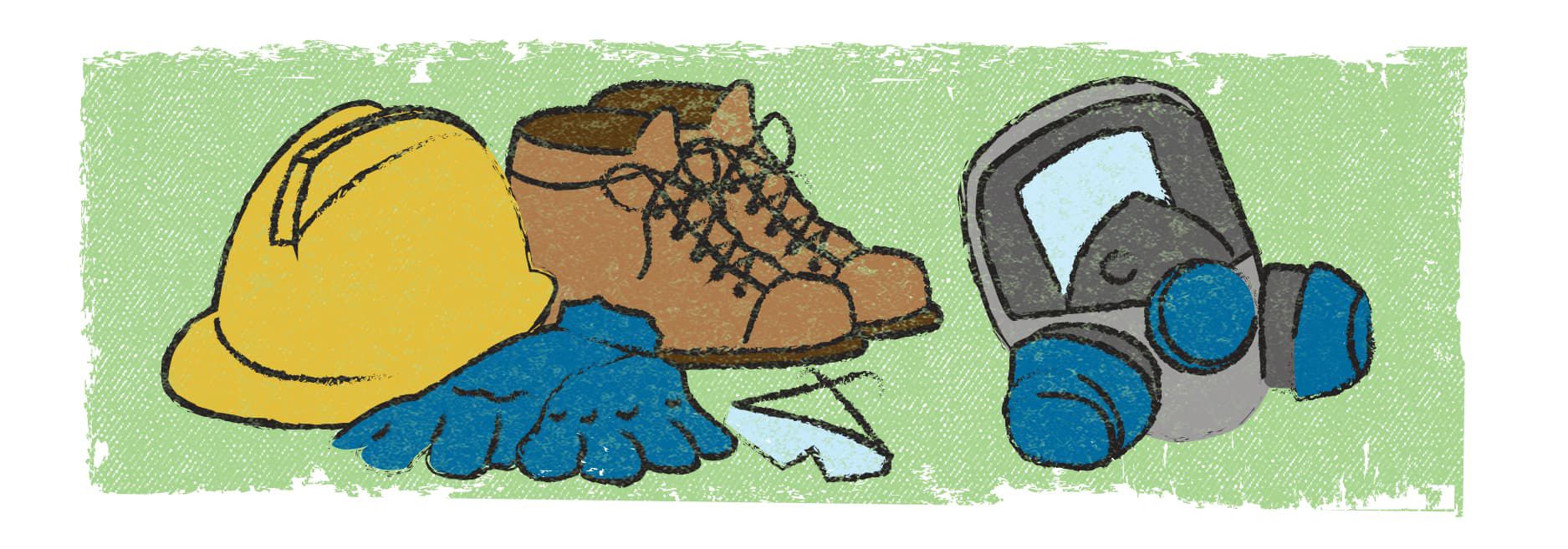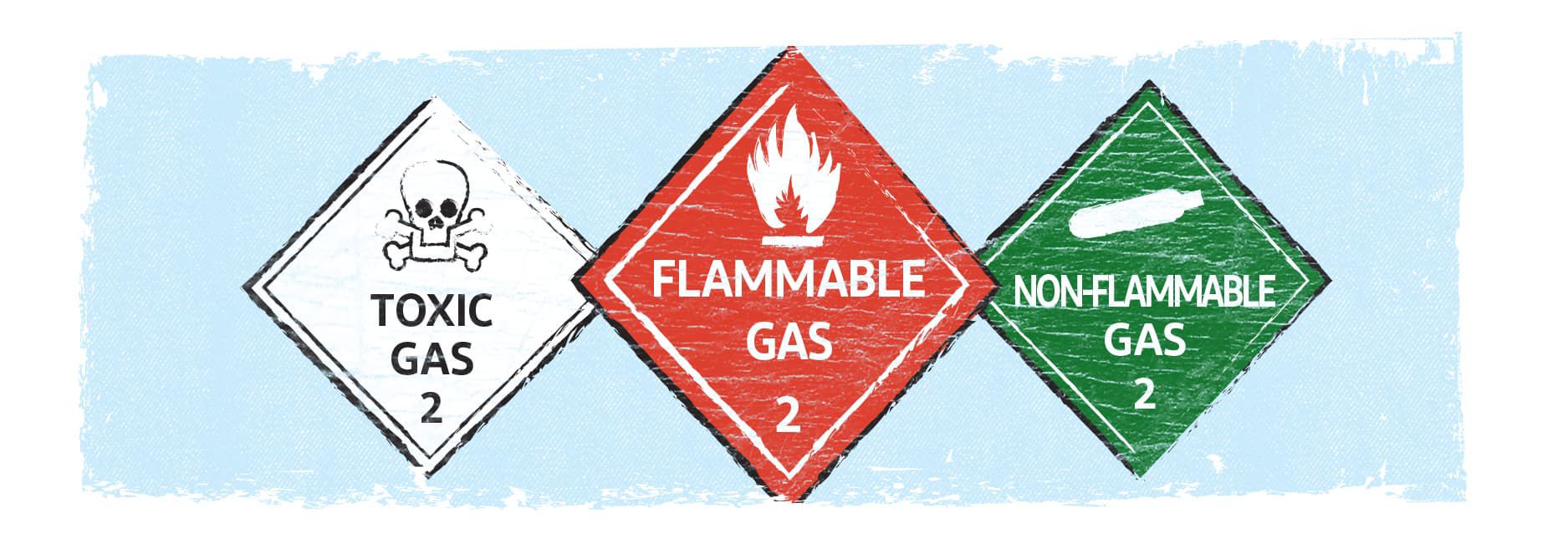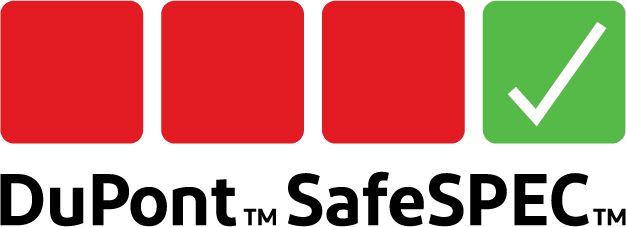Better safe than sorry
By Michael Halliwell
M. Eng., EP, P.Eng., Senior Environmental Engineer, Thurber Engineering Ltd.

As an environmental engineer, my life deals with looking for things that many clients hope I don’t find. Although my job involves soil and groundwater a majority of the time, I am also involved in radon and hazardous building materials assessments. Generally speaking, my job is not what most people think of when they find out I’m an engineer.
I recently had a client come to us for an assessment of five gas sites before the infrastructure was removed and the sites were decommissioned. These sites were in rural locations and, for a couple of them, the comments we received were, “Oh, there’s nothing there, so you probably won’t have to do anything with them.” Looking at the information provided, I could understand why the client thought so. There wasn’t much infrastructure left there.
Still, regardless of the site, I’ve learned to take safety seriously. So out came the usual gear for a gas site: hard hat, safety boots, safety glasses, coveralls made with DuPont™ Nomex®, gloves and the gas monitors. When we actually started sampling, the respirators came out too. I know a lot of us have become used to working with masks during the pandemic, but full-face respirators are not generally a fun piece of equipment to wear all day. However, industrial sites can have a pretty high potential for asbestos, so if we’re going to be carving out samples, it’s better to be safe than sorry.
The job went well. We got our samples, made sure to handle everything as if it contained asbestos and got our gear cleaned up properly after the job. Well, wouldn’t you know it…when we got the lab results back, over a quarter of the samples came back with chrysotile asbestos (some as high as 80 percent) and a few additional samples came back with wollastonite (a silicate industrial mineral used as an asbestos replacement that often contains fine quartz). Yes, even at the two sites where “there’s nothing there,” we found asbestos.
Let’s face it. Safety gear can be time consuming to get on and a bit of a pain in the rear, and as a result, we can be tempted from time to time by the old, “Oh, it’ll just take a second” type of jobs to not get fully geared up. What experience has taught me, and these site assessments have confirmed, is that there are no small jobs as far as safety is concerned. Do it right; it is better to be safe than sorry.
Hazmat through history – Gas masks
By Daniel Hammel
North America Marketing Lead – Chemical Industrial

In our first installment of “Hazmat through history” back in The Glow Worm Spring 2016 issue, we took a look at plague doctors during the bubonic plague of the 17th century. These medics from yesteryear wore prominent birdlike masks to ward off “bad air,” which was thought to be a cause of the plague. In the beak area of the mask, dried flowers, spices and other aromatic substances were added to help filter what the plague doctors were breathing in.
While you might think this crude, beaked mask was the first example of people using a tool or device to filter the air they breathe, there are earlier examples. In ancient Greece, sponges were used as a primitive type of gas mask. In ninth century Persia, the Banu Musa brothers developed a rudimentary gas mask to help protect workers in polluted wells. Centuries later, in the late 1700s, Alexander von Humboldt, a Prussian mining engineer, invented the first device with a respirator to help protect miners working and breathing in unsafe mines.
In 1847, American engineer Lewis P. Haslett is credited with creating a gas mask that resembles today’s respirators. Haslett received a patent for his device, which included an air filter and a vent, allowing air to be breathed through the nose and mouth and exhaled into the atmosphere. In the decades following Haslett’s step-change invention, several improvements were made to gas masks and respirators.
By the 1900s, gas masks had become associated with wartime. During World War I, soldiers used gas masks to protect themselves from chlorine gas attacks. When World War II began—with the first world war still fresh in many people’s minds—the demand for gas masks for civilians grew in some English population centers. Following the attack on Pearl Harbor, fears grew of a chemical attack in the United States, as well. While most adults may be able to get past the jarring look of a gas mask, it was believed that the sight of them would make children nervous or frightened and that children would refuse to wear the potentially lifesaving devices as a result. To combat this problem, the Sun Rubber Company, with the design and approval of Walt Disney, manufactured gas masks for children that looked like Mickey Mouse. They hoped the design would quell children’s fears of donning the mask in the event of a chemical attack. Fortunately, the gas masks were not needed in the United States, and only about one thousand masks featuring the familiar cartoon face were actually produced.
Modern respiratory protective equipment (RPE) is available for myriad applications and in various forms, including cartridge respirators, powered air purifying respirators (PAPRs) and self-contained breathing apparatus (SCBA), to list just a few. Advancements and innovations continue to be made in the form and function, as they have for the past couple hundred years.
DuPont Personal Protection offers a variety of coveralls with respirator-fit hoods. Explore your options at DuPont™ SafeSPEC™.
Hazmat on the go – Transportation regulations: Gases
By Kathryn Novelli
Senior Marketing Analyst

Handling and transporting hazardous materials are the reality of a modern and dynamic supply chain. Whether the hazardous cargo is a final product destined for market or a byproduct of the production process that must be disposed of, hazardous materials transportation remains a necessary part of contemporary commerce.
Traveling with hazardous materials is serious business and maintaining safety is of the utmost importance. To help workers stay safe, the United States Department of Transportation (DOT), established in 1966, and its operating organizations oversee regulations and requirements for the safe transportation of hazardous materials.
The Federal Motor Carrier Safety Administration (FMCSA) and the Pipeline Hazardous Materials Safety Administration (PHMSA) work in tandem to advise and enforce regulations in relation to the DOT’s nine classes of hazardous materials.
The next stop on our Hazmat on the Go series is Class 2: Gases.
Hazardous gases, as defined by the DOT and FMCSA, include compressed, dissolved under pressure, or pressurized cryogenic liquids and liquefied gases and can be toxic, flammable or nonflammable. Examples of commonly transported hazardous gases include petroleum gases, like propane and butane, as well as chlorine gas and anhydrous ammonia. Uses for hazardous gases are wide-ranging, including use in household applications like cooking, heating and powering appliances, to applications as a refrigerant or agricultural fertilizer, in addition to inclusion in product manufacturing processes for pharmaceuticals, computers, automobiles and aircraft parts. While OSHA provides guidance for the storage, use and handling of hazardous gases in the workplace, many regulations for hazardous gases are overseen by the DOT, in conjunction with the PHMSA and FMCSA.
The DOT designates gases as a Class 2 hazardous material, which is further categorized into three divisions:
- Division 2.1: Flammable gases
- Division 2.2: Nonflammable, nontoxic gases
- Division 2.3: Toxic gases
These classifications are used for cargo labeling and vessel placarding, as required by the DOT.
Frequently, hazardous gases are transported via trains on railways, specifically in pressure tank cars. Pressure tank cars can carry all three division classifications for gases and include protective housings and no bottom fittings. Most pressure tank cars maintain pressure above 40 psi. When being transported via road, hazardous gases are often moved using pressurized road trailers. Different models of road trailers vary in appearance, function and allowable cargo, but most feature an emergency shut-off valve at the front of the tank, near the driver door.
Transporting hazardous gases can be extremely dangerous. On June 28, 2022, in Jordan, an accident involving a toxic chlorine gas explosion occurred which killed at least twelve people and injured 250. CCTV footage captured the moment when a crane malfunctioned while it had been hoisting a storage tank carrying around thirty tons of gas. The crane dropped the container onto the deck of a ship, breaking the container and engulfing the Aqaba Port in a poisonous, yellow chlorine gas cloud. Jordan’s civil defense force and area medics arrived at the scene immediately and took injured people to two nearby hospitals.
In case of an accident involving the transportation of hazardous gases, the operator must call the emergency response telephone number included on the shipping paper for the cargo, or if unavailable, contact an appropriate emergency response service. Emergency response actions vary depending on the type of hazardous gas released in an accident and the conditions of the accident, including the size of a leak, toxicity of the gas and the presence of fire. The use of chemical protective clothing and self-contained breathing apparatus (SCBA) is often required in addition to flame-resistant clothing when responding to emergencies involving flammable and corrosive or toxic gas. Furthermore, since many gases are heavier than air, they will spread along the ground and can collect in lower elevation or confined areas. Evacuation of the area and isolation of the accident are often vital in ensuring public safety.
Knowledge of transportation regulations and best practices for hazardous materials is paramount to keeping people safe, on and off the road. Through diligent adherence to safety standards and awareness of emergency response procedures, hazmat transporters can help keep roads safe for everyone.
To learn more about how to protect yourself from different hazardous materials and to find out which DuPont products offer suitable protection for your needs, visit SafeSPEC™.
Do you have a story you’d like to share about transporting hazardous materials? Email kathryn.novelli@dupont.com to discuss being featured in our next edition of The Glow Worm.
What can a CIH do for me?
By the DuPont Personal Protection CIH Team: Mark Tartaglia, CIH; Damien Hammond, CIH, CSP; and Kay Dietrich, CIH, CSP

Industrial hygiene is the anticipation, recognition, evaluation and control of workplace hazards. It’s an interdisciplinary practice blending the sciences of chemistry, biology, physics, toxicology, math and engineering, and their application to solve worker health and safety challenges. Industrial hygienists typically possess a college bachelor's degree and, in many cases, an advanced degree.
Certification in industrial hygiene is one of several certifications within the field of occupational and environmental health and safety (OEHS) professional disciplines. An individual who achieves the certification is referred to as a Certified Industrial Hygienist (CIH). To qualify as a CIH, the individual must meet certain educational and experience requirements, as well as pass a comprehensive exam.
CIHs practice in a wide variety of workplace settings, including in industry, government, academia and environmental services, and are subject matter experts in health and safety risk assessment. They develop and implement solutions for worker protection by applying the hierarchy of exposure controls – hazard elimination/substitution, engineering controls, administrative/work practice controls and personal protective equipment (PPE).
DuPont Personal Protection (DPP) retains a team of CIHs supporting the DuPont™ Tyvek® and DuPont™ Tychem® product lines. This support takes the form of several types of assistance for end users of these products:
- Providing technical support related to the proper selection of product solutions
- Developing technical guidance documents
- Developing and delivering training content
- Direct CIH-to-CIH peer interactions
- Targeted on-site hazard risk assessments
What does a support engagement with a DPP CIH look like?
A typical engagement to assist with product selection involves contact between an end user and a CIH team member via telephone or email. The end user needs to provide critical information regarding the details of their exposure application so the CIH can offer suitable solution options. Included among the information needed for a comprehensive evaluation is:
- Detailed description of the task(s) involved with the exposure application
- List of the hazard(s) and the concentration(s) and physical state(s) involved with the application; for chemicals, safety data sheets (SDSs) should be provided
- Intensity, duration, direction and temperature associated with contact exposure to the PPE
- Current PPE being used, if any, and any associated issues with its use
Based on the information provided, the CIH will complete an analysis against product performance data in order to offer solution options for the end user to consider. The more complete the information provided is, the more useful the guidance offered.
Be aware that the suggested options are only options – not recommendations – for the end user to choose from. It is the end user’s legal responsibility to select appropriate PPE that matches the exposure hazards for their employees.
How can a CIH assist with PPE selection for emergency responders?
Emergency responders can take advantage of CIH support services during their pre-planning process, based on items identified during routine inspections (e.g., fire marshals), or based on factors like bulk goods transportation observations. Based on the pre-planning results, a DPP CIH can help identify PPE product options for potential scenarios faced by industrial or public emergency responders.
Additionally, a DPP CIH team member can provide training in how to search our extensive product permeation testing database and the product selector tools available in SafeSPEC™, our web-based, mobile-friendly product information resource. SafeSPEC™ helps emergency responders to self-identify product solutions and appropriate applications in the event that a CIH team member is not readily available. To learn more, visit SafeSPEC™.
Learn more about the DuPont Personal Protection Certified Industrial Hygienist services by contacting Allie Fletcher here.
Products and/or sales questions?
Share your stories, tips and tricks.

Resource library
Find technical information, videos, webinars and case studies about DuPont PPE here.


